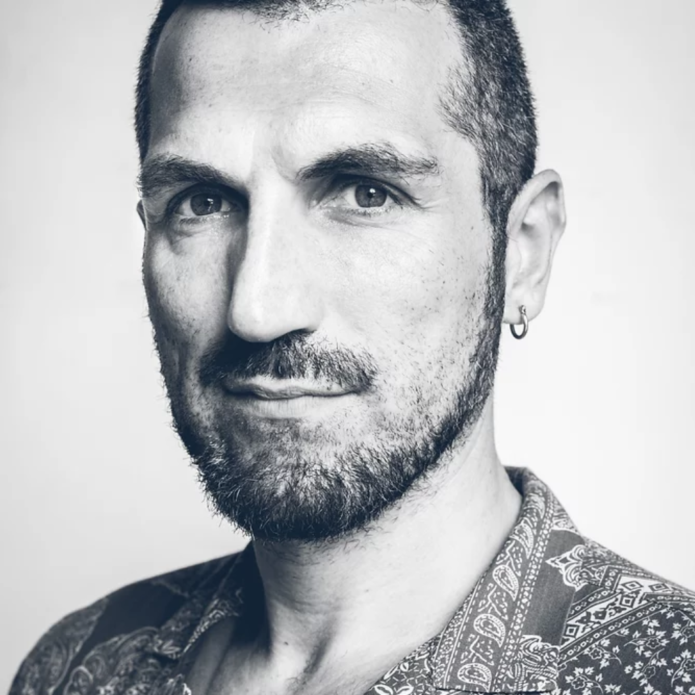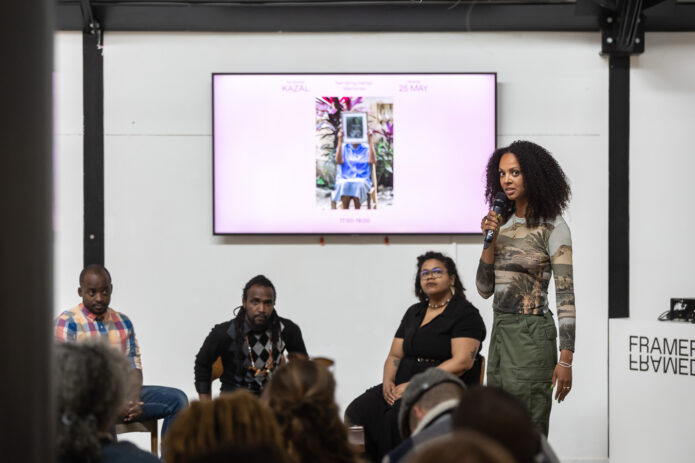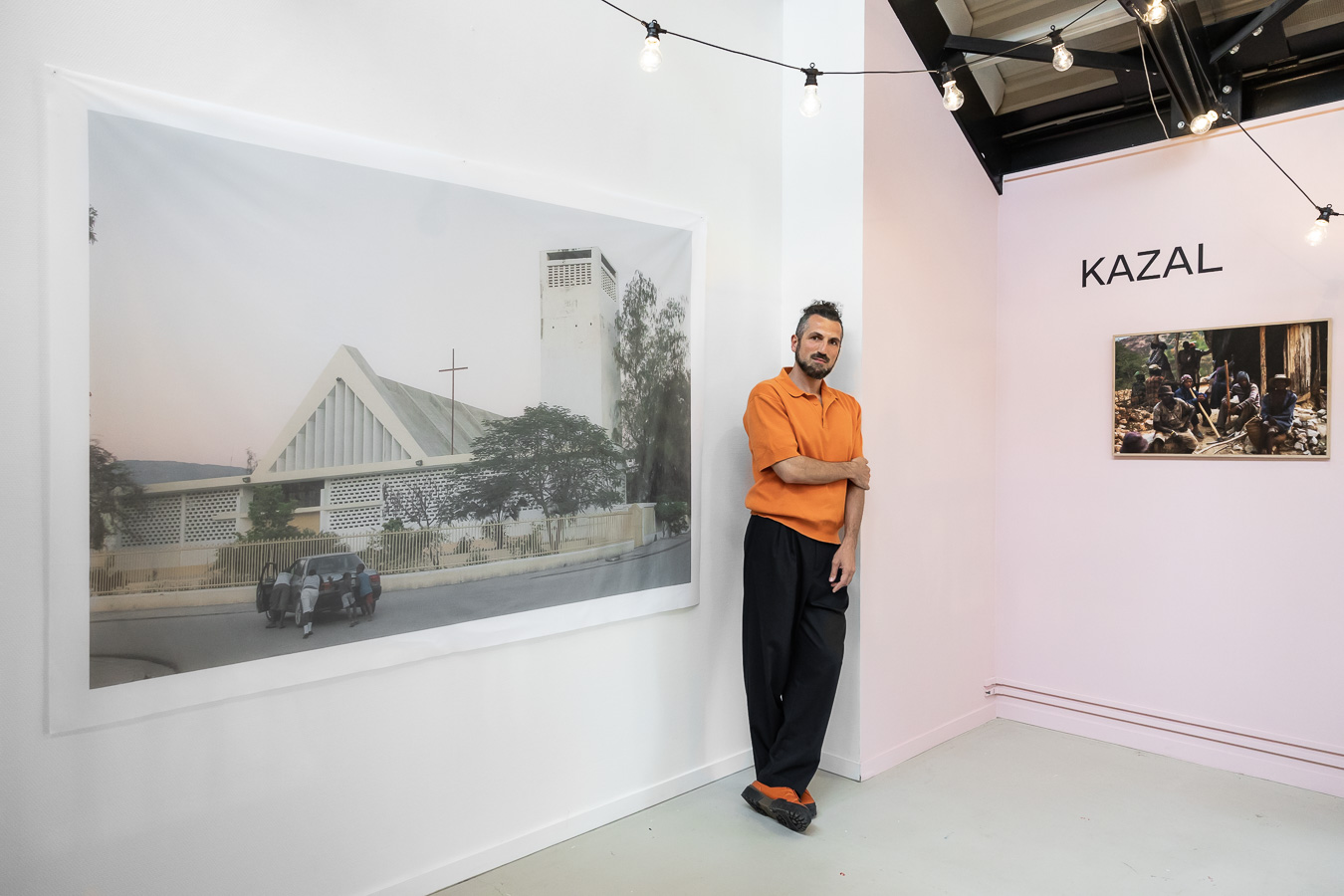 KAZAL: Narrating Haitian Memories - Curator Nicola Lo Calzo. Photo: Maarten Nauw / Framer Framed
KAZAL: Narrating Haitian Memories - Curator Nicola Lo Calzo. Photo: Maarten Nauw / Framer Framed The Kazal Project: Tracing the Memory Through the Haitian Gaze
Scroll down for French
By Nicola Lo Calzo
May 2022
For Kolektif 2 Dimansyon (K2D), the practice of photography means above all informing, documenting, testifying, through the lens, of a given reality. Their approach to photography has been built over the years in the relationship with the Haitian national press and the international media, in response to a demand from the news, as the multiple political, economic, social, ecological crises who regularly cross the country and who often make the front page of international newspapers.
Their work is nurtured and is flourishing in dialogue with the many foreign photographers and journalists who have worked or lived in Haiti since the early 90s, such as Alex Webb, Bruce Gilden, Chantal Regnault, Paolo Woods, Arnaud Robert, Leah Gordon to name a few, also with renowned Haitian news photographers like Thony Bélizaire who Haitian cinematographer Raoul Peck paid tribute a few years ago by publishing the book Witness to History: Images of the Struggle for Democracy in Haiti (1986-2013). In this respect, their photographs continue, while going beyond, the experience of photojournalism and the tradition of ‘street photography’. This reference is an important component of their photographic practice, which it is important to look at and think about, in order to avoid a biased reading of their work.
It is clear that this documentary approach to photography is an exception in the panorama of contemporary photography from Afro-diasporic worlds, particularly in the Caribbean. Within these contexts, different photographic registers prevail, I am thinking of the self-portrait, stage photography, or even fashion photography. This ‘Haitian exception’ constitutes, in my opinion, one more reason to watch these works with particular interest.
The images presented here are not the product of an exercise in style or an artistic approach (without minimising their interest here). They are rather the fruit of a body-to-body engagement with the subject photographed, in the occurrence the inhabitants of Kazal, a small village north of Port-au-Prince, the site of one of the worst massacres under François Duvalier’s dictatorship in 1969. According to Fabienne Douce, Edine Célestin, Georges H. Rouzier, Reginald Louissaint Jr., Moïse Pierre, and Mackenson Saint Felix, the urgency was not to create and display ‘beautiful’ images but to repair an injustice, documenting a disappearing oral and visual memory: make invisible memories visible in a race against time. For good reason: most of the witnesses to the massacre have since passed away. These images are ‘beautiful’ because they look for justice, they aims to be ‘right’: it is precisely in this engaged approach, close to the sociological survey and far from reflectors, that we find the strength of this project and its political and decolonial value.
In line with their previous works, K2D tackle the challenge of documentary photography head on, conducting interviews, researching sources and fieldwork, a constant and often uneasy dialogue with the subjects photographed. In doing so, they are, for the first time in their practice, addressing the multiple challenges of a project on memory: memory of place, memories of bodies, memories of the massacre. And they managed to accomplish all this in a country, the Republic of Haiti, where, apart from a few stubborn historian and civil society organisations, hardly any real work of public and official memorisation was done since the end of dictatorship.
When we think of memory, we generally accept the significance of the term as a given, without a deep understanding of its definition. But what is memory? And in what ways can photography contribute to a work of remembrance such as which is contained in this exhibition? Can a work of photography on memory become the carrier and creator of memory, transmitting and revitalising from a perspective that moves beyond the intention of the photographer?
Photography remains a fragmentary witness, partial, subjective, polysemic: a photograph tells us as much about the photographed subject as it does about its photographer. It remains an interpretation of reality that is never fully within our grasp. As American photographer Diane Arbus stated, “A photograph is a secret about a secret”. Furthermore, photography has infinite material physicalities: paper, cardboard, posters, etc., as well as infinite immaterial numerical values.
However, this versatility does not reduce its value as testimony and index, the “ça a été” (it was there) in the words of Roland Barthes, and it is precisely from this perspective that the photographers of the K2D collective have built The Kazal Project.
The photographs presented in this exhibition deliberately leave open all of these questions. Made as part of a master class I conducted for over three years and coordinated by Maude Malengrez, head of the media program of the Fondation Connaissance et Liberté (FOKAL), they are divergent and multiple but they certainly have a common goal: to make visible to Haitians as well as the entire world the multiple and contradicting living memories of one of the most tragic and major events in modern Haitian history: the Kazal massacre in 1969 under François Duvalier’s dictatorship.
These images restore this visibility through the valuable complementarity of a dual outlook. On one hand we are presented with the direct and indirect witnesses of facts, the places where this took place and the ways in which their memory is inscribed into the landscape as well as the everyday life of the inhabitants of Kazal. On the other hand, the perspective of five Haitian photographers who think, see, and photograph this memory, drawing from their own experience as Haitians, all of them part of the first post-Duvalierist generation.
In addition to the point of view of each photographer, the power of this project is in this multiple perspective which defines the narration from start to finish and is acknowledged as the fundament of the whole narrative. As a result, the visual storytelling reflects the specific relationship between the photographers and their subjects.
The creative process included various stages and degrees. For the photographers as well as for the photographed subjects, what ensued was a true encounter with Haiti’s troubled past that, to this day, has not yet been acknowledged. This achievement was also a long and complex personal journey, where the photographers were forced to navigate social, cultural, and geographical barriers. City dwellers of the capital came face to face with rural Haitian universe, “le pays en dehors”, literally “the country outside” as the countryside is often called in Haiti, naming the fact that although the country lives on the farmers contributions, they are barely considered nor properly taken care of in the economic, social and political system.
This journey was forged by the deep connection with the residents, on the trust built and nurtured over the course of the years between 2015 and 2018, on many successes and also failures. What ultimately prevailed was the unwavering determination to return to these same places, to listen, to show, to share, and to bring new research leads, new images, new witnesses for the dissemination of memory. As Édouard Glissant said, “Each and every one of us needs the memory of the Other, not because of virtuous compassion or charity, but because of a new lucidity that comes from the process of Relation. And if we want to share the beauty of the world, if we want to stand in solidarity with suffering, we must learn to remember together.”
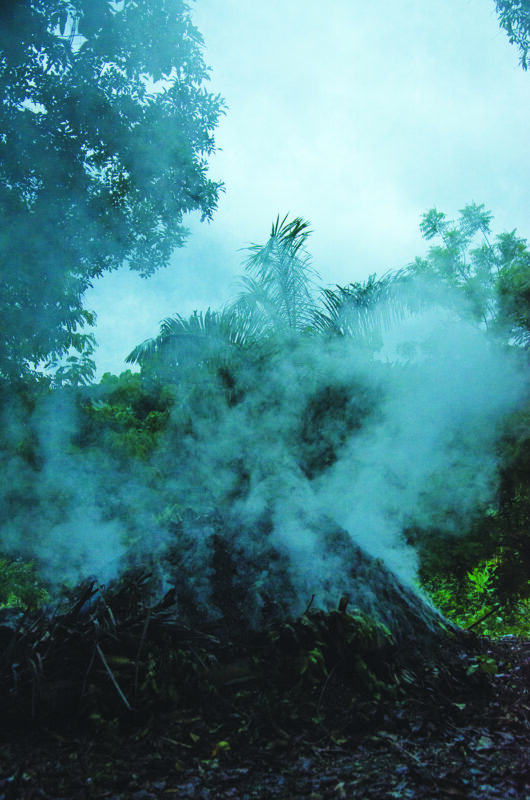
Photo: Georges Harry Rouzier
Burning wood for the production of charcoal, one of the sources of income for the inhabitants of Kazal | Bois en flammes pour la production de charbon, une des sources de revenu pour les habitants de Kazal
LE PROJET KAZAL: RETRACER LA MÉMOIRE PAR LE BIAIS D’UN REGARD HAÏTIEN
Par Nicola Lo Calzo
Mai 2022
Pour le Kolèktif2d, photographier signifie avant tout informer, documenter, témoigner, par l’objectif, d’une réalité donnée. Leur approche à la photographie s’est construite au fil des années dans la relation avec la presse nationale haïtienne et les médias internationaux, en réponse à une forte demande en provenance de l’actualité, notamment les multiples crises politiques, économiques, sociales, écologiques qui traversent régulièrement le pays et qui font souvent la Une des journaux internationaux.
Leur travail s’est nourri et a grandi en dialogue avec les nombreux photographes étranger.e.s qui ont sillonné Haïti depuis le début les années 90, tels Alex Webb, Bruce Gilden, Chantal Regnault, Paolo Woods, Arnaud Robert, Leah Gordon pour n’en citer que quelques un.e.s. mais aussi de célèbres photographes de presse haïtiens comme Thony Bélizaire, auquel le cinéaste haïtien Raoul Peck a rendu hommage il y a quelques années avec l’ouvrage Témoin de l’Histoire : Radiographie d’une transition démocratique en 100 photos, 1986–2013. À cet égard, leurs photographies s’inscrivent, tout en le dépassant, dans le socle de la tradition du photojournalisme et de la street photography. Cette référence est une composante assumée de leur pratique photographique à partir de laquelle il est important de regarder et penser ce travail, faute de quoi, on risquerait de s’égarer dans une lecture biaisée de leur œuvre.
Force est de constater que cette approche documentaire à la photographie fait figure d’exception dans le panorama de la photographie contemporaine issue des mondes afro-diasporiques, notamment dans la Caraïbe. Dans ces contextes, des registres photographiques tout-à-fait différents prévalent, je pense à l’autoportrait, à la stage photography, ou encore à la photographie de mode. Cette exception haïtienne constitue, à mon avis, une raison de plus pour regarder ces travaux avec un intérêt particulier.
Les images ici présentées ne sont pas le produit d’un exercice de style ou d’une démarche plastique (sans en minimiser ici l’intérêt), mais plutôt le fruit d’un engagement corps à corps avec le sujet photographié, en l’occurrence les habitants de Kazal, un petit village au nord de Port-au-Prince, lieu d’un des pires massacres sous la dictature de Duvalier. Dans le regard de Fabienne Douce, Edine Célestin, George Harry Rouzier, Réginald Louissaint Jr., Moïse Pierre et Mackenson Saint Felix, l’urgence n’a pas été celle de créer et afficher des « belles » images mais de réparer une injustice, en documentant une mémoire orale et visuelle en voie de disparition. Rendre visible des mémoires invisibilisées dans une course contre la montre. À raison. La plupart des témoins du massacre sont, depuis, décédés. C’est précisément dans cette démarche engagée, proche de l’enquête de terrain et loin des réflecteurs, que l’on retrouve la force de ce projet et sa valeur politique et « décoloniale ».
Dans la continuité avec leurs précédents travaux, ils relèvent ici le défi de la photographie documentaire, basée sur des entretiens, des interviews, une recherche sur les sources, un dialogue constant et pas toujours facile avec les sujets photographiés, en s’attaquant, pour la première fois dans leur pratique, aux multiples enjeux d’un projet sur la mémoire : mémoire du lieu, mémoires des corps, mémoires du massacre. Et cela dans un pays, la République d’Haïti, où aucun véritable travail de mémoire collective et officielle n’a été fait depuis la fin de la dictature.
Lorsque l’on parle de mémoire, l’on considère généralement comme acquise la signification de ce terme, sans se poser le problème de sa définition. Mais qu’est-ce-que la mémoire ? Dans quelle mesure la photographie peut contribuer à un travail de mémoire comme celui raconté dans cette exposition ? Et encore, est ce qu’un travail photographique sur la mémoire peut devenir lui-même porteur et créateur de mémoire, dans une perspective de transmission et de revitalisation qui dépasse l’intention du photographe ?
La photographie reste un témoignage fragmentaire, partiel, subjectif, polysémique : une photographie nous apprend sur un sujet photographié autant que sur son photographe. Elle demeure une interprétation de la réalité qui ne se laisse jamais complètement saisir. Comme l’affirme Diane Arbus, « la photographie est un secret sur un secret ». Plus encore, elle peut se démultiplier à l’infini dans la matérialité physique – papier, carton, panneaux, etc. – et dans l’immatérialité numérique. Cette versatilité ne réduit pas, pour autant, sa valeur de témoignage et d’index, le « ça a été » dans les mots de Roland Barthes, et c’est justement à partir de cette prise en compte que les photographes du collectif K2D ont construit le projet Kazal.
Les photographies présentées dans cet ouvrage, réalisées dans le cadre d’un master-class conduit par le ci-nommé et coordonné par Maude Malengrez, responsable du pôle média de la Fondation Connaissance et Liberté – FOKAL, laissent délibérément ouvertes toutes ces questions mais elles ont certainement une ambition en commun : celle de rendre visible, pour la première fois aux Haïtiens autant qu’au monde entier, les mémoires vivantes multiples et contradictoires d’un des plus remarquables évènements de l’histoire moderne haïtienne : le massacre de Kazal.
Elles nous restituent cette visibilité à travers la précieuse complémentarité d’un regard croisé : d’un côté les témoins directs ou indirects des faits, les lieux où ces faits se sont déroulés et les manières dont leur mémoire s’est inscrite dans le paysage et dans la vie quotidienne des habitants de Kazal. De l’autre coté le regard de six photographes haïtiens qui pensent, voient et photographient cette même mémoire à partir de leur propre expérience en tant qu’Haïtiens, toutes et tous issus de la première génération post-duvaliériste.
Par-delà les regards individuels de chaque photographe, la force de ce projet réside dans cette double perspective qui définit la narration du début à la fin et qui est assumée comme un parti pris de toute la narration. Dans ces termes, il a été question de réaliser un travail photographique documentaire et collectif qui puisse refléter la relation particulière entre les photographes et leur modèle.
Le processus de création s’est fait par étapes et par degrés. Pour les photographes ainsi que pour les sujets photographiés, cela a été une véritable rencontre avec l’histoire et le passé trouble de l’île, qui, à ce jour, n’a pas encore été publiquement assumé ; il s’est agit aussi d’un parcours personnel long et complexe, où les photographes ont dû ruser avec d’anciennes barrières sociales, culturelles et géographiques : eux, citadins de la capitale à la rencontre des Kazalais, la plupart d’entre eux, des paysans et des cultivateurs de la terre.
Ce parcours s’est construit sur les contacts noués avec les habitants, sur la confiance établie au fils des séjours réguliers entre 2015 et 2018, sur les succès et sur les échecs aussi, comme dans toute démarche artistique qui va à la rencontre de l’Autre. Mais ce qui finalement a primé a été l’obstination à revenir sur ces mêmes lieux, pour écouter, montrer, partager et apporter de nouvelles pistes à la recherche, de nouvelles photos, de nouveaux témoignages à la circulation de la mémoire : comme l’affirme Edourard Glissant, « chacun de nous a besoin de la mémoire de l’autre, parce qu’il n’y va pas d’une vertu de compassion ou de charité, mais d’une lucidité nouvelle dans un processus de la Relation. Et si nous voulons partager la beauté du monde, si nous voulons être solidaires de ses souffrances, nous devons apprendre à nous souvenir ensemble ».
Curatorial Text / Caribbean / Conflict / Photography /
Exhibitions
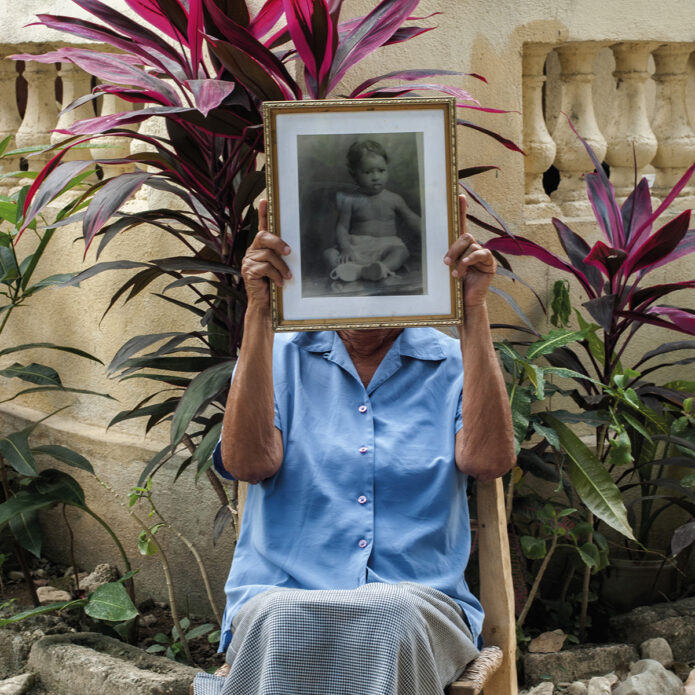
Exhibition: KAZAL – Narrating Haitian Memories
With Kolektif 2 Dimansyon & Tessa Mars
Agenda
Opening: KAZAL - Narrating Haitian Memories
With Georges H. Rouzier, Reginald Louissaint Jr., Tessa Mars & Alessandra Benedicty-Kokken
Network
